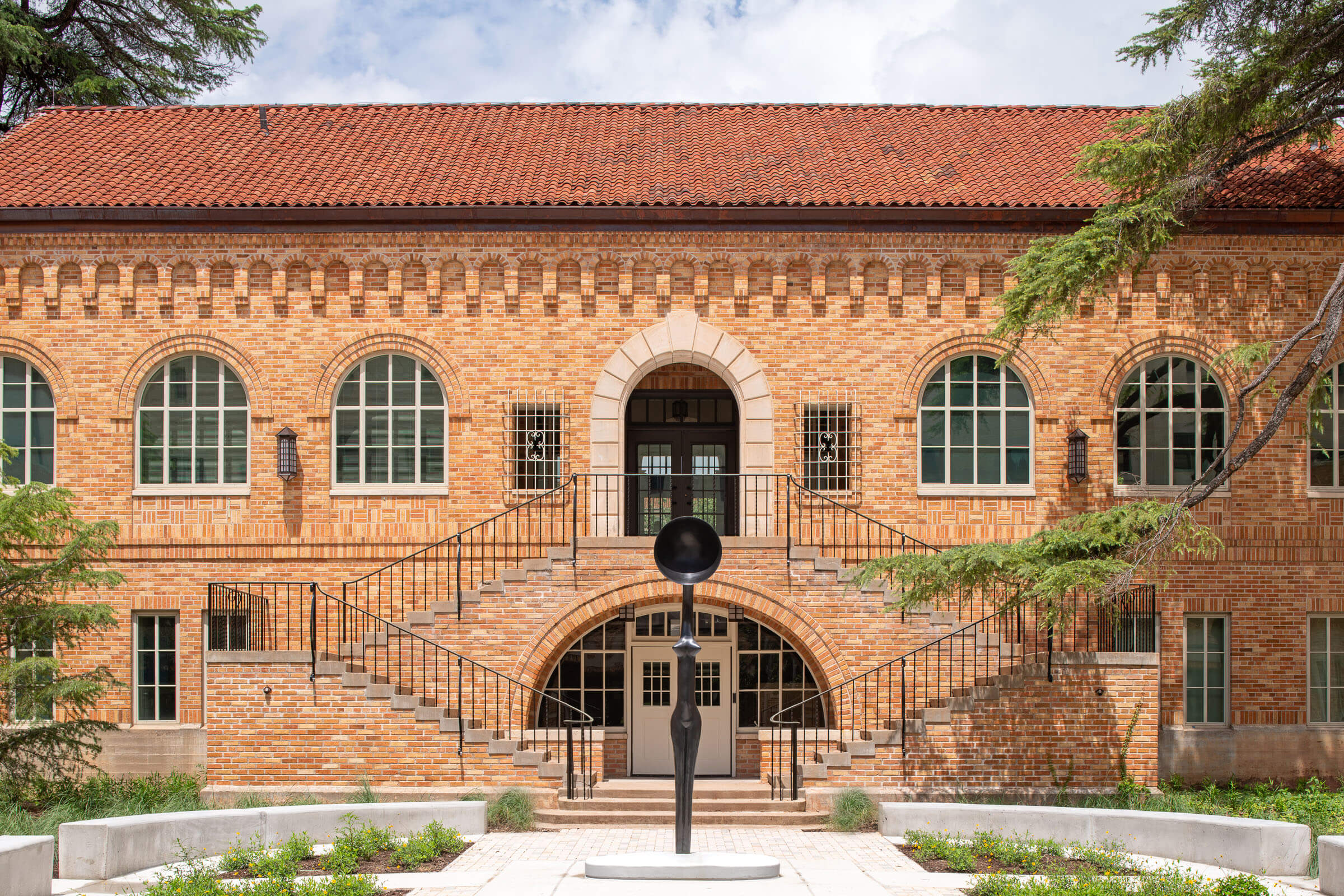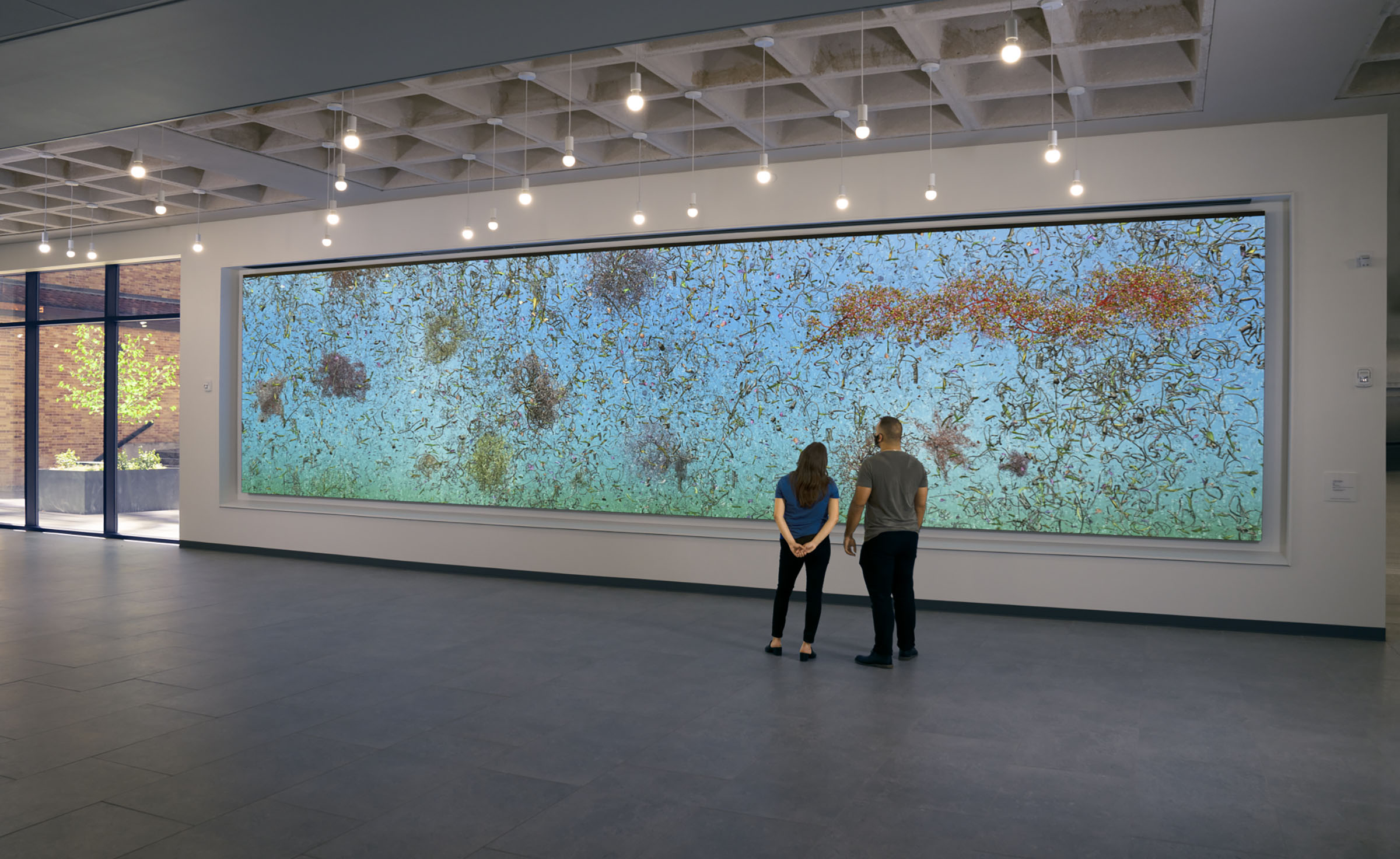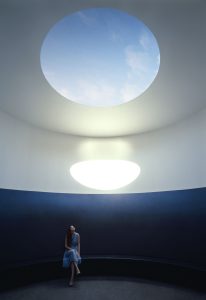
Simone Leigh, Sentinel IV, 2020. Photo by Paul Bardagjy. Courtesy of Landmarks, the public art program of The University of Texas at Austin.
As a longtime Austinite who is not an alumna of the University of Texas at Austin, I rarely had reason to set foot on campus—until I was invited to be part of a public art tour and found myself in the lobby of Welch Hall, where chemistry and biophysics are taught in the College of Natural Sciences. Instantly I found myself drawn to, and hypnotized by, pink, yellow, and green marine single-cell organisms swimming contentedly across a digital canvas about the size of a residential pool. The pulsating biomorphic shapes and grasses undulating through the peaceful waters cast a spell over me and the other observers in my tour group as they welcomed us into the tranquility of the canvas. This installation, EON by artist Jennifer Steinkamp, is one of 50 modern and contemporary art pieces in the Landmarks collection, the public art program located throughout the 433-acre campus.
As a guest of the Campbell Art Collective, a members-only club in Austin, I was introduced to the Landmarks collection by its deputy director, Kathleen Stimpert. She gave our group of about 20 a taste of the world-class collection on a tour that culminated at The Color Inside, part of James Turrell’s Skyspace series and arguably one of the best-known pieces at UT. According to Stimpert, it’s visited by 75,000 people a year from all over the world.
Fortunately, you don’t need an invitation to experience this collection. Anyone can take a university-offered public tour on the first Sunday of the month, or a self-guided tour any day of the week using the mobile app.
With Austin being home to great art collections, including the Blanton Museum, which recently underwent a redesign and minor facelift and is also on the UT campus, and the sculpture gardens at the Umlauf near Zilker Park and the Contemporary Austin’s Laguna Gloria location, the Landmark’s collection can easily be overlooked, especially if you are unfamiliar with the UT campus—but it’s worth a visit for any art lover.
Accessible to the public and free to all, it was established in 2008 at the direction of the university’s Master Plan for the creation of a public art program and launched in partnership with a longtime loan of 27 pieces from New York’s Metropolitan Museum of Art, instantly giving credibility to the collection. Most of the pieces are sited outdoors and are sculptural three-dimensional in nature, but you can also find murals, photographic portraits, and digital works.

Jennifer Steinkamp, EON, 2020. Photo by Christina Murrey. Courtesy of Landmarks, the public art program of The University of Texas at Austin.
On our tour we were shown some of the highlights, like the Steinkamp piece, as well as Mark di Suvero’s giant red-crossed I-beams and circular “knotted” center sculpture Clock Knot in front of the Cockrell School of Engineering; the Monochrome for Austin sculpture of 70 recycled aluminum canoes and small boats clustered at the end of a listing column by Naples, Texas, native Nancy Rubins at 24th Street and Speedway; and Simone Leigh’s Sentinel IV, a mystical slender bronze guardian with elongated proportions and a faceless bowl crown in front of the Anna Hiss Gymnasium Courtyard. Other artists representing Texas in the collection are Peter Reginato from Dallas and Sarah Oppenheimer from Austin.
According to Stimpert, funding for the collection is similar to many municipal public art programs. “Landmarks is set up as a percent-for-art program,” she explains. “And that simply means that we receive 1% to 2% of the budgets for new construction or major renovation projects on campus. These allocations fund the acquisition and commission.” She stresses that no money comes from the budgets that serve students or that provide financial aid and adds that the works “are funded exclusively through these capital improvement projects.”
When a renovation of an existing building is called for, or a new project is launched on campus, such as the recent announcement of a new medical center at the site of the Erwin Center, that’s when Landmarks has the ability to procure new works. “We look at the budget, we look at how the building will be used, we’ll look at its history,” Stimpert says, “and then we put together a short list of artists that would be appropriate for the site. So, the process is not one in which we say, ‘Oh, we want to put a work by artist X at the College of Engineering.’ It really is all dictated by the project parameters. And that will give us a starting point for the types of artists that can be considered.”

James Turrell, The Color Inside, 2013. Photo by Florian Holzherr. Courtesy of Landmarks, the public art program of The University of Texas at Austin.
To maintain a cohesive collection, the Landmarks committee, composed of architects, artists, historians, and landscape architects, considers many things in determining which works to add. They’ll look at the stature of the artist in the industry and the relevance of the work from an art history perspective; they’ll look at the relationship of the work to other works in its vicinity as well as the collection as a whole “both in terms of aesthetics and thematically and in terms of materials,” Stimpert says. Other criteria include the work’s durability and its potential contribution to UT’s cultural environment.
“What’s neat about Landmarks and what distinguishes our public art collection from others in Austin is that we present over eight decades of work,” Stimpert says. “None of the other programs in town provide a historical overview of public art in the way that Landmarks does.”
Not only does Landmarks stand out in Austin, but it stands out nationally as one of the top three university collections in the United States, Stimpert says, in the company of the Stuart Collection at the University of California at San Diego and MIT’s collection in Cambridge, Massachusetts.
A collection of this depth and breadth is certainly a value to not only the UT students and faculty, but for anyone who chooses to step foot on the campus and gaze up and around them. Like me, they may even find themselves besotted and engaged by strange, new, and wonderful creations.
“We hope the public art collection is a source of inspiration for everyone,” says Andrée Bober, founding director and curator of Landmarks. “We want it to start conversations, ignite imaginations, and leave lasting impressions. But most importantly, we hope that sharing our stories and experiences brings us all closer together, and that the collection makes all Texans proud.”
Art Education
Add these college campuses with public art collections to your future itineraries
Houston
Public Art University of Houston System
Established in 1969, Public Art UHS has a collection of over 700 pieces across five of the university’s seven campuses. Highlights include a collection of Andy Warhol photographic prints and Polaroids and crowd favorite Double Physichromie by innovative artist Carlos Cruz-Diez.
Moody Center for the Arts Rice Public Artworks
Established as a university-wide arts initiative in 2008, the Rice Public Art Collection spans across 300 acres of the campus with works by leading contemporary artists such as Michael Heizer, Shirazeh Houshiary, Beverly Pepper, Ursula Von Rydingsgard, and Mark di Suvero. James Turrell’s Twilight Epiphany Skyspace is also a signature piece in the collection.
Lubbock
Public Art Collection, Texas Tech University System
Started in 1998, the university’s public art collection has more than 150 works spread out over its six campuses and was named by Fodor’s as a top outdoor art museum to visit.
Various Locations
Texas State University System
Created in 2008, the Texas State University System’s collection has over 350 works of art valued at over $10 million and placed over seven campuses, from Beaumont and Huntsville to San Marcos and Alpine. Texas sculptural artist Nic Nicosia was recently named the commissioned artist for the Sam Houston State University Recreation Sports Building expansion in Huntsville.








